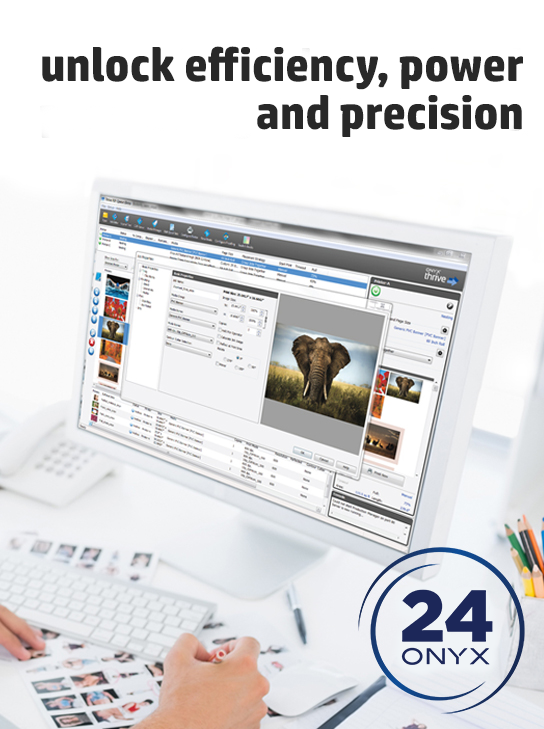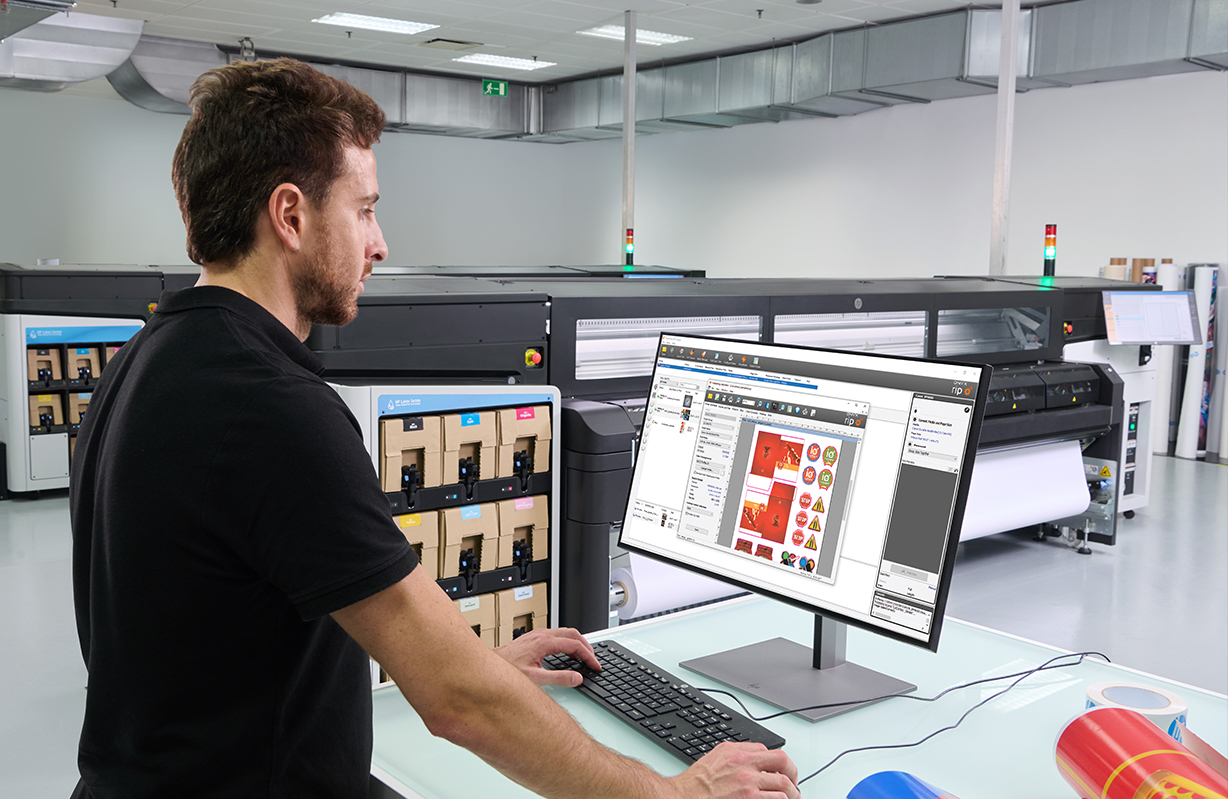RIP Software
-
Read more ...
The world of garment printing is evolving rapidly, introducing innovative technologies that make printing on textiles faster, more efficient, and more versatile than ever. Among these advancements, Direct to Garment (DTG) and Direct to Film (DTF) printing stand out as game-changing methods for producing vibrant, high-quality designs on a variety of materials.
Whether you’re a seasoned professional or exploring new ways to expand your printing business, understanding new technologies is key to staying ahead in a competitive industry.
In this blog, we’ll break down how DTG and DTF printing work, explore the benefits of each, and show you how SAi Flexi DTF DTG software makes these processes more streamlined and accessible than ever.
Ready to dive into the details? Let’s get started.
Direct to Garment (DTG) Printing
Direct to garment printing, often known as DTG printing, is the method of using a computer to transfer a digital image to a specialised printer that jets ink directly onto a textile or garment.
The way direct to garment printing operates is different from traditional screen printing in that you can swiftly print intricate images in numerous colours thanks to the relatively new technology. The print heads of a DTG printer spray CMYK ink and opaque white ink onto the surface of a garment. The ink dries and clings to the fabric by being heated, keeping the print in place.
Direct to Film (DTF) Printing
Direct to film printing is an even newer addition to the garment/textile printing industry. The process is slightly different from DTG in that, as the name implies, the design is not directly printed into the material but instead printed on a film before being transferred using a heat press.
The most notable advantage DTF has over DTG is that it allows you to print on most any type of fabric, such as polyester, nylon, rayon, spandex, cotton, etc. In DTG printing the only reliable material to print on is cotton.
SAi Flexi Software for DTG/DTF Printing
Direct to Film and Direct to Garment printing is one of the fastest-growing segments in our industry. SAi Flexi software for DTF DTG printing makes it easier than ever to diversify your business. A new, expanded feature set in Flexi simplifies artwork design and file preparation for DTF DTG printing, streamlining your workflow and saving you time on each job.
Benefits of SAi Flexi for DTF DTG Printing:
Easy to Use Interface
All DTF DTG tools are conveniently organized under one tab, so you won’t waste time scrolling through menu bars to find what you need. User-friendly dialog boxes allow you to quickly make changes to your artwork files. With Flexi, you spend less time preparing jobs and more time printing.
Versatile White Ink Workflow
White ink is an integral part of DTF DTG printing but can tricky if you don’t have the right software. Flexi gives you different workflow options for generating white layers quickly and easily. Whether you are working with .PNG or .TIFF files that have transparent backgrounds or artwork that contain no white at all, Flexi gives you the tools create transparencies, add masks, and assign white output channels with just a few clicks. For more precise output, you can also use Flexi to create multi-layer artwork with white on a separate layer from spot colours. Flexi gives you the versatility you need to easily handle different types of files without wasting time.
Higher Quality Prints Using Ink Removal
Everyone loves graphic tees, but no one wants a stiff, heavy print on their shirt. If you have a large print, you can give it a softer feel by using Flexi’s special DTF|DTG feature to “Remove Data in Texture Patterns”. This feature allows you to add squares, circles, or dash lines to your pattern. You can adjust the size and spacing of these elements to so less ink is deposited, giving your prints a high-quality, softer texture.
Less Material Waste – Preview Before You Print
Ink and media are expensive, which is why you want to make certain your job is set up correctly before you print. Flexi lets you preview each output channel within the Production Manager interface. Not only can you see how the white layer will print but you can also adjust the white ink density using a simple slider. With these Flexi tools, you can make certain the job is right without wasting ink and media.
Best of all, our textile design and printing software is available on a low-cost monthly subscription plan that easily fits your budget.
About SA International (SAi).
Headquartered in Salt Lake City, Utah, SA International (SAi) is recognised as the global leader in providing software solutions for the sign making, digital printing, textile, and CNC machining industries - from design to production. SAi's Flexi family of software products rank as the world's number one software for sign making and digital printing, outselling all competitors combined. Flexi is found on more wide-format printers than any other software. In addition, the company is one of the leaders in the CNC machining and router markets with its EnRoute CAD/CAM software.
SAi has a large and loyal network of resellers around the world and has over 250,000 customers in more than 150 countries. SAi enjoys strong OEM relationships with industry-leading manufacturers. In addition to its USA headquarters, SAi has offices in Brussels, Belgium, Sao Paulo, Brazil, Shanghai and Hong Kong, China, Pune, India, Tel Aviv, Isreal and Tokyo Japan.
-
Read more ...
In the world of wide-format printing, colour management is not just a technical detail - it’s a cornerstone of quality and consistency. Whether you’re creating vibrant marketing materials, detailed fine art prints, or large-scale signage, ensuring accurate colour representation is critical to maintaining brand integrity and customer satisfaction.
The Challenges Of Maintaining Colour Fidelity
Wide-format printing comes with unique challenges. Variations in media types, ink formulations, and environmental factors can all affect colour output. Without proper management, what looks perfect on a screen might appear dull or inconsistent when printed. For businesses, this can lead to wasted materials, increased costs, and dissatisfied clients.
How ONYX Solutions Address These Challenges
ONYX’s award winning software simplifies colour management with powerful tools designed for precision and consistency:
- ONYX ColorCheck: This feature ensures colour accuracy by verifying output against industry standards. It allows you to detect and correct inconsistencies early, preventing costly reprints.
- Advanced Profiling Tools: ONYX provides robust profiling capabilities that adapt to various media and printer combinations. These tools help create and maintain colour profiles that guarantee accurate reproduction, no matter the material or application.
- Named Colour Replacement: Maintain a library of brand-specific colours to ensure every print adheres to exact branding requirements, essential for corporate identity and marketing campaigns.
Tips For Achieving Optimal Colour Output
- Create Accurate Profiles
Accurate ICC profiles are essential for reliable printing. Use profiling tools to match your printer, ink, and media, ensuring vibrant and consistent results tailored to your workflow. - Calibrate Regularly
Printers and monitors naturally shift over time due to environmental changes and usage. Regular calibration helps maintain accuracy, especially when switching to new substrates or working in different conditions. ONYX Thrive’s ‘ColorCheck’ simplifies this process by creating a baseline swatch to detect variances and ensure consistency. - Use ONYX Tools
ONYX software offers advanced tools like ‘ColorCheck’ and G7 calibration to monitor and adjust output quality. These features make it easy to spot and correct issues early, keeping your prints sharp and consistent. - Understand Your Media
Each substrate has unique properties that affect how it interacts with ink. Testing and fine-tuning your profiles for different media ensures the best results, whether you’re printing on paper, vinyl, or specialty materials.
By combining these strategies with ONYX tools, you’ll maintain flawless colour consistency and deliver standout prints every time. Learn More With ONYX Understanding the nuances of colour management can elevate your printing results from good to exceptional. ONYX Graphics offers specialised color management training courses designed to deepen your expertise and empower your team with the knowledge to handle even the most complex projects. Take control of your colour today and see the difference ONYX can make in your workflow. For more details on training and ONYX solutions, contact PSW for further details
About Onyx Graphics, Inc.
Leading the market since 1989, Onyx Graphics is dedicated to helping customers increase productivity, reduce costs, and gain a competitive edge with superior software solutions for the print industry. Innovative, productive, and delighted customers around the globe help motivate the company to develop and enhance its leading-edge technologies. Global channel partnerships and longstanding relationships with printer manufacturers position Onyx Graphics as a market leader in powerful, reliable, large-format printing workflow and print business software solutions.
-
Read more ...
ONYX Graphics, a leader in RIP software solutions, proudly announces that ONYX 24 has earned full certification for the new HP Latex FS50 and FS60 printer series. This certification from HP ensures that ONYX 24 integrates smoothly with HP’s latest printers, delivering excellent colour control, media management, job processing, and workflow efficiency. For print service providers, this means a streamlined, user-friendly experience that brings out the best in HP’s advanced large-format printing capabilities.
Achieving full certification means that ONYX 24 has passed extensive testing by HP to confirm seamless compatibility and optimised performance with the HP Latex FS50 and FS60. This ensures that ONYX 24 can handle all key functions of these printers—from precise colour management to enhanced workflow efficiencies—so users can rely on consistent, high-quality results.
Chukwuma Peter Eze, Manager of Product Management & Partnerships at ONYX Graphics, emphasided, “This certification highlights our commitment to providing solutions that enhance HP’s newest large-format technology. ONYX 24 is designed to deliver excellent colour accuracy, smooth job management, and expanded white ink options, helping our customers achieve high-quality, efficient print production.”
Key Features of ONYX 24 for HP Latex FS50 and FS60 Printers:
- Enhanced Colour Management: ONYX’s proprietary colour engine offers precise colour control, taking full advantage of the broader colour range provided by the new HP Latex FS series.
- Advanced Media Management: Easily manage different media types with ONYX’s Media Manager, designed for optimal ink usage and media savings across various applications.
- White Ink Capabilities: Leverage advanced white ink options for unique applications, including spot colour overlays and layered printing on transparent media.
- Print & Cut Workflow: ONYX’s contour cutting tools provide an efficient Print & Cut workflow, helping users make the most of their materials while improving finishing quality.
With a focus on sustainability, the HP Latex FS50 and FS60 printers use water-based inks, producing odourless, eco-friendly prints without hazardous air pollutants. ONYX 24 complements this approach, aligning with HP’s commitment to environmentally conscious printing.
About Onyx Graphics, Inc.
Leading the market since 1989, Onyx Graphics is dedicated to helping customers increase productivity, reduce costs, and gain a competitive edge with superior software solutions for the print industry. Innovative, productive, and delighted customers around the globe help motivate the company to develop and enhance its leading-edge technologies. Global channel partnerships and longstanding relationships with printer manufacturers position Onyx Graphics as a market leader in powerful, reliable, large-format printing workflow and print business software solutions.
-
Read more ...
For small businesses, especially print shops, keeping track of finances can be particularly challenging. Owners often juggle multiple roles, from managing day-to-day operations to handling customer service and marketing. Disorganised records, missed invoices, and inaccurate financial tracking can lead to cash flow problems and hinder business growth.
With limited resources, staying on top of financials can become overwhelming.
With ONYX Align’s latest update, there’s a clear path to streamlined and efficient financial management. Introducing the new QuickBooks® Online integration - a revolutionary feature for print shops looking to simplify their financial operations.
How Does it Work?
This new feature allows ONYX Align to connect directly to QuickBooks, an online accounting software that assists in payroll, payments, and more.
You can either create a new QuickBooks account to connect to your Align or use a pre-existing QuickBooks account. Either way, this new feature on Align allows you to establish real-time synchronisation between the two accounts to manage estimates, invoices, payments, customers, products, tax rates, payment methods, and payment terms.
Effortless Financial Management
Once you connect your accounts, you can enter any of your financial data into either ONYX Align or QuickBooks, and both accounts will automatically update with the information you input. This makes your financial management effortless and organised, eliminating the need for manual updates and reducing the risk of errors.
Key Benefits of QuickBooks® Online Integration
Direct Connectivity
Establish a seamless link between your ONYX Align and QuickBooks Online accounts for streamlined operations. This direct connection ensures that your financial data is always up-to-date and accurate, providing a clear picture of your print shop’s financial health.
Live Synchronisation
Enjoy real-time updates of customer accounts, jobs, tax rates, payment terms, and methods. With live synchronisation, you can be confident that your financial records are always current, no matter where you enter the data.
Estimate and Invoice Automation
Experience the convenience of automatic creation and real-time status updates of estimates and invoices within QuickBooks Online, all issued directly from ONYX Align. This automation reduces the time spent on administrative tasks, allowing you to focus more on growing your business.
Automated Payment Tracking
Maintain up-to-date records with live synchronisation of all payment activities and invoices, enhancing financial tracking and reporting. This feature ensures that you never miss a payment and always have an accurate view of your financials.
The ONYX Align team is excited to share this seamless integration with QuickBooks Online. This new feature ensures that your print shop has optimised and streamlined operations within your financial management. Say goodbye to the chaos of disorganized records and hello to clarity and efficiency.
Ready to transform your print shop’s financial management?
To try ONYX Align today and experience the benefits of seamless QuickBooks integration contact PSW Paper & Print for an online demonstration.
-
Read more ...
Onyx Graphics Inc. is excited to introduce ONYX 24, the latest in its line of RIP (Raster Image Processor) software, designed to revolutionise wide format print workflows. This new version boasts intuitive tools that automate processes and ensure efficient colour management, promising to enhance productivity across the board.
In today’s fast-paced print industry, businesses are increasingly reliant on streamlined workflows to meet growing demands. ONYX 24 addresses these challenges head-on with cutting-edge automation controls that minimise manual intervention, accelerate production timelines, and significantly reduce potential errors. This means smoother operations and more consistent output quality, essential for maintaining competitiveness in the market.
Understanding RIP Software
RIP software is pivotal for transforming digital images into high-resolution prints. It optimises images by adjusting colour balance, brightness, and contrast before translating them into a format compatible with the printer. This software is indispensable for printing companies and businesses utilising wide format printers, ensuring that large-scale prints retain their intended quality and clarity.
Why Upgrade to ONYX 24?
ONYX 24 is tailored to meet the evolving needs of modern print environments. It’s not just about speed and efficiency; it’s also about usability and sustainability. Key features of ONYX 24 include:
- Multilayer Printing: Seamlessly stack and adjust multiple images for applications like posters, fine art, and signage, allowing for creative flexibility and precise control.
- Named Colour Replacement: Maintain a library of brand-specific colours to ensure consistency across all prints. This feature is invaluable for marketing materials, package designs, and corporate branding efforts. Save colours and settings from images as filters and create stunning multi-layer prints with accurate previews using enhanced spot layer generation.
- Label Placement: Easily add labels above, below, or on images, and place data and QR codes anywhere. This feature is designed to reduce mistakes with artist-friendly options.
- Nest Preview and UI Enhancements: Customise and zoom in on the nest preview dialog box to easily visualise and choose specific layers before printing.
- Nix Spectro 2/L Colour Device: Enhance color accuracy with the Nix Spectrophotometer, a compact device that connects via Bluetooth. It offers a range of colour profiles and references, keeping your prints up to date with the latest industry standards.
- Archive: Safeguard your data with ONYX Archives. Securely store and access previous job and client files, preventing data loss with guaranteed access.
- Best Fit and Allow Rotation 2.0: The new algorithm optimises image placement for all resolutions, reducing media waste while ensuring quality and saving money.
- Fotoba Enhancements: Improved cutting workflow includes vertical line notch placement and barcode offsets, perfecting print details before cutting.
- New Mimaki XY Slitter Placement: Connect to ONYX 24 for flexible print-and-cut options, with compatibility for cutter marks on other printers.
- Flood Fill Behind Marks: Improve mark visibility by flooding the area around images with a customisable spot colour on dark, transparent or reflective media, ideal for all cutter types.
- Background Colour Under Marks: use any ink colour to create a footprint underneath each mark specific to your cutter, optimising mark visibility while also saving ink and space.
ONYX recognises the critical role of reliable RIP software in achieving superior print results. ONYX 24 seamlessly integrates into existing workflows, providing effortless automation and precise colour management tools that empower users to deliver exceptional prints consistently.
As Onyx Graphics prepares for the launch of ONYX 24, we invite you to stay tuned for updates as we discover how these advanced features can transform your printing experience, making it simpler, faster, and more sustainable than ever before.
-
Read more ...
Raster Image Processing software, commonly known as RIP software, is an integral tool for any printing professional looking to deliver the finest quality of prints with the sharpest detail and colour variance. But what actually is RIP software, and how does it work? Even experienced employees, who have worked in the printing industry for many years, may find their knowledge about this topic limited.
There is a fair bit to uncover, even about the basics of RIP software. It is also equally important to know how RIP software differs from other regular printer drivers and how it performs to fundamentally improve your images. With the help of this article, expect to advance your understanding of RIP software and explore our expert tips, plus advice, on using it to fully capitalise on its benefits.
What Is RIP Software?
RIP software is a type of software that offers more control over your print production. It optimises digital images for printing by converting them from their native file formats into high-resolution raster images. With RIP software, you'll have control over every element of your workflow, from image editing to colour accuracy and overall print quality.
You can use it to adjust your image's colour, brightness, and contrast and handle other advanced printing techniques. On a technical level, there is so much you can do with RIP software to generate better prints.
RIP software aims to make printing easier, faster, and more accurate. It bypasses all other programs, allowing your computer to communicate directly with your digital printer. A computer-aided design operator will have access to pre-designed products and an option to create unique, customised print designs. If you would like to produce high-quality prints, RIP software can help you in the following ways:
- Easy manipulation of print (scaling, rotating, cropping)
- Creation of a more efficient printing process
- Automation of duplicate tasks like the placement of multiple files on a single sheet
- Ensuring consistency across multiple printers
- Creation of presets depending on your needs
- Accurate control over the print's colours
Image print RIP software eliminates the complexities of printing while ensuring you achieve superior printing quality.
Key Benefits of RIP Software
Speed
One of the key benefits of RIP software is its speed in processing your prints. The entire process happens within minutes, allowing your company to meet customer demands while retaining high quality. You can process multiple files, easily manipulate your prints, and create presets that speed up your printing process.
RIP software allows you to produce high-quality products by giving you complete control over the print files. You can adjust your print's scaling, opacity, colour correction, dot size, and other features to meet the desired print quality. This is especially crucial when printing large format prints. RIP software can resize your images while maintaining their quality.
Production Efficiency
RIP provides efficient functionalities and features that significantly optimise your company's printing workflow. It supports the simultaneous processing of multiple large files and ensures accurate prints and consistency across various printers.
Therefore, using RIP for your daily printing tasks means fewer reprints, reducing the wastage of paper and ink. This results in more efficient production that saves time and money.
How to Properly Use RIP Software for Printing
RIP software is essential in the production of high-quality printed products. It can be easily installed and used with different printers, including large format printers. Here is how to properly use RIP software for printing and enjoy the numerous workflow benefits.
Prepare Your Files for Printing with RIP Software
Image print RIP software offers an intuitive interface that makes it easy to prepare your files for printing through the following steps.
Set Up Print Parameters
After you launch ImagePrint RIP software, you can set up your print parameters:
- Select your Printer
- Set the Page Size, Quality, Roll/Sheet and Media Type
These settings may vary depending on the printer you're using.
Select Your Media Outlet Profiles
You can take the following steps to select a Printer Profile for the paper you'll use:
Click on Choose by Profile to choose from already downloaded profiles.
Configure Your Colour Management Settings
After acquiring the printer profiles, configure your colour management settings:
- Expand the Printer selection area.
- Select either ImagePrint manages colours or Printer manages colours.
Send Your Files to a Printer Using RIP Software
When you're ready to print, you can send your file to a printer by:
- Click on the Print button at the top of the Dashboard.
- Click OK to confirm your print settings.
Monitor the Printing Process
You can use Spoolface to control and monitor the printing process through the following steps:
- Click on the Printer icon on the top right to open the Job Manager.
- Look at the top Active side to see the job that's printing.
- Monitor the job's progress in the Job Progress area on the right. It'll also show any errors or warnings that may arise.
- Once it's done, it'll move to the bottom Saved side.
- Monitor the printer's current status at the bottom left corner. Error codes will appear here in case the job runs into a problem.
What Are Some of the Advanced RIP Software Techniques?
RIPs offer a wide range of advanced features that enhance the printing process while improving the final product's quality. These features include:
- Colour management: Image print RIP software allows you to create ICC profiles, modify ink capacity, and offer linearisation control. You'll have superior colour management features to help you create accurate prints.
- Halftoning: Creates halftone patterns to ensure high-quality production of continuous-tone images
- Automation: Automate the printing process, including repetitive print jobs such as smart cropping, sizing, multi-page layout, tiling, and more.
- Scaling: Scale images without losing resolution.
- Job management: Manage print jobs such as scheduling and tracking.
With RIP software, you can effortlessly produce high-quality prints that meet and exceed your expectations.
Ensure Print Quality and Production Efficiency by:
Nesting
Nesting allows you to combine multiple files into one print job. RIP software will automatically organise images, shapes, and objects to maximise your print material. It will calculate and figure out the best positions to place them. This ensures efficient use of the space on your print, reducing the wastage of materials.
Tiling
RIP software includes tiling features, allowing you to print larger images without cutting off design elements. When an image is larger than your media size, tiling breaks it into specific sizes your printer can handle. Tiling separates the design image into multiple pieces that can then be printed on multiple pages. Tiling is crucial when you get a job too wide for your printer.
Imposition
When printing your work, RIP software utilises the imposition feature to combine various print works and print them simultaneously. This minimises the printing time and significantly reduces paper waste by maximising the number of orders per impression and thoroughly filling the print sheet. Proper planning and positioning allow your work to be printed effectively and in an orderly fashion.
Reach Out to PSW to Learn More About RIP Software
RIP can greatly affect your printing processes and output quality. It enables creativity, streamlines production, and improves workflow while reducing costs. Therefore, if you would like to increase efficiency and improve profitability, consider investing in RIP software and a high-quality large format printer.
At PSW, we have the right printing solutions for your business. We can help you utilise powerful RIP software to produce high-quality printed products with our extensive range of top-notch large format printers. Contact us today to learn more.
-
Read more ...
Exploring the Future of Flexi: Flexi Complete:- In the ever-evolving landscape of design and printing software, staying ahead of the curve is paramount. Enter Flexi Complete, the latest offering from SAi, promising a suite of cutting-edge features to revolutionise the way professionals in the industry work. Let’s delve into what makes Flexi Complete a game-changer for designers, printers, and sign makers alike. Flexi Complete is the same Flexi you know and love but with a fresh new look and a bevy of improvements. Let’s see what’s new.
A Better User Experience
One of the standout features of Flexi Complete is its commitment to providing a seamless user experience. Flexi Complete brings a new look to the intuitive interface of Flexi. Designed to streamline workflows, users can navigate the software with ease, saving both time and effort. Whether you’re a seasoned professional or just starting out in sign making, DTF DTG, direct-to-vinyl, or other wide format printing applications Flexi Complete’s user-friendly design ensures that you can hit the ground running from day one.
Enhanced Design Capabilities
Flexi Complete empowers designers with enhanced capabilities to bring their creative visions to life. With an array of new tools and functionalities at their disposal, users can push the boundaries of design like never before. From advanced vector drawing tools to dynamic effects and filters, Flexi Complete offers unparalleled flexibility and control, allowing designers to unleash their creativity without limitations.
Optimised Printing Workflow
Efficiency is key in the world of printing, and Flexi is engineered to optimise every step of the printing workflow. With robust finishing tools and advanced color management features, users can ensure that their prints are accurate and of the highest quality, every time. Whether you’re producing large-scale signage or intricate graphics, Flexi’s printing capabilities are second to none.
Seamless Integration
Flexi seamlessly integrates with existing workflows, making it easy to incorporate into your existing setup. Whether you’re using other design software, RIP software, or hardware devices, Flexi plays nice with others, ensuring a smooth transition and minimal disruption to your operations. Flexi Complete offers a total package from design to production, including a powerful 64-bit RIP to give users a seamless workflow from start to finish.
Commitment to Innovation
At its core, Flexi Complete is a testament to SAi’s commitment to innovation. With a dedication to pushing the boundaries of what’s possible, SAi continues to raise the bar in the world of design and printing software. Flexi Complete is not just a product but a reflection of SAi’s ongoing mission to empower professionals in the industry with the tools they need to succeed.
With its intuitive interface, enhanced design capabilities, optimised printing workflow, seamless integration, and commitment to innovation, Flexi Complete is made to revolutionise the way professionals in the sign and print industry work. Whether you’re a designer, printer, or sign maker, Flexi Complete is the ultimate tool to bring your creative visions to life.
About SA International (SAi).
Headquartered in Salt Lake City, Utah, SA International (SAi) is recognised as the global leader in providing software solutions for the sign making, digital printing, textile, and CNC machining industries - from design to production. SAi's Flexi family of software products rank as the world's number one software for sign making and digital printing, outselling all competitors combined. Flexi is found on more wide-format printers than any other software. In addition, the company is one of the leaders in the CNC machining and router markets with its EnRoute CAD/CAM software.
SAi has a large and loyal network of resellers around the world and has over 250,000 customers in more than 150 countries. SAi enjoys strong OEM relationships with industry-leading manufacturers. In addition to its USA headquarters, SAi has offices in Brussels, Belgium, Sao Paulo, Brazil, Shanghai and Hong Kong, China, Pune, India, Tel Aviv, Isreal and Tokyo Japan.
-
Read more ...
Onyx Graphics, Inc., a pioneer in wide-format digital printing solutions and RIP software development, is set to preview ONYX 24 and unveil the much-anticipated ONYX Sync at FESPA 2024. Version 24 introduces features such as automated multi-layer printing, seamless mobile device integration, and advanced print quality assurance. These innovations continually demonstrate the company's commitment and capability in powering the next generation of automated printing solutions for print operators and businesses worldwide.
Introducing ONYX 24: Elevating Print Workflow Efficiency
ONYX 24, the company’s latest release in RIP software, introduces major optimisations that address key industry challenges in print automation and efficiency. Developed with feedback from industry professionals, version 24 achieved major breakthroughs, including automated multi-layer preparation for spot colours and effects, mobile spectrophotometer calibration, and embedded workflows for colour verification.
This release marks a significant leap forward, with end-to-end automation that transforms integrated print management. Key technical highlights include:
- Easy Multi-Layer Printing: Achieves effortless multi-layer printing through automated generation of layers based on spot colours, varnish, or other special printing effects. This feature streamlines complex file preparation by eliminating manual separation of elements across layers, saving valuable time while ensuring quality.
- Wireless Support for NIX Spectro Devices: Introducing native support for the NIX Spectro 2 and Spectro L spectrophotometers via Bluetooth. This new wireless connectivity powers the next generation of colour measurement, enabling wireless reading and calibration at an affordable price.
- Colour Accuracy Verification: Users can now add a ColorCheck Baseline Swatch to newly created profiles to verify the accuracy of future prints. This is achieved by incorporating a ColorCheck Strip at the time of profile generation, subsequently establishing a quality baseline for printers. When future print jobs utilise this process control feature, the same patches can be measured in order to verify that the prints continue to adhere to colour quality benchmarks, allowing for the detection of drift over time and to prevent errors.
"ONYX 24 marks a major milestone in our commitment to address practical challenges faced by the printing industry," said Matt Crawford, CEO of Onyx Graphics, Inc. "With this release, we're fully ready to roll out our most innovative RIP solutions to our European customers, empowering our users with the tools they need for unparalleled efficiency and success.”
ONYX Sync: The Future of Print Shop Automation
ONYX Sync is the latest REST API developed to enable print service providers (PSPs) to grow and automate their businesses. Our solution enables print shops to fully streamline and align their print production processes with various business tools, and to connect ONYX Thrive with users’ existing business management software to enhance workflow efficiency and productivity.
This API integration empowers print shops to eliminate manual tasks, minimise operational errors, and conserve essential production time, resulting in advantages such as:
- Real-time production feedback and status updates through an intuitive API.
- Seamless integration with existing business management software, eliminating manual intervention.
- Automated job submission and management tools for increased efficiency and scalability.
- Enhanced communication and job status notifications for better customer service.
“ONYX Sync drives tremendous sustainability gains through automated production efficiency,” said Crawford. “The seamless integration with ONYX Thrive optimizes workflows to minimize waste, create circular material usage, and provide robust analytics for carbon and environmental impact management. By embracing API and IoT technologies to reduce print resource intensity, we firmly believe ONYX Sync creates a greener model for the future.”
About Onyx Graphics, Inc.
Leading the market since 1989, Onyx Graphics is dedicated to helping customers increase productivity, reduce costs, and gain a competitive edge with superior software solutions for the print industry. Innovative, productive, and delighted customers around the globe help motivate the company to develop and enhance its leading-edge technologies. Global channel partnerships and longstanding relationships with printer manufacturers position Onyx Graphics as a market leader in powerful, reliable, large-format printing workflow and print business software solutions.
-
Read more ...
Onyx Graphics, Inc., a leader in providing wide-format software solutions, today announced the global availability of ONYX 22.5, the company's newest version release of industry-leading wide-format RIP and print workflow software that was previewed with great acclaim at FESPA Global in Munich, Germany earlier this year.
ONYX 22.5 introduces ONYX Archive for effortless backup, search, restoration, and management of print jobs, and is connected directly to the main ONYX user interface as a standard feature for the entire portfolio of ONYX RIP and print workflow software solutions. "We're thrilled to unveil ONYX 22.5 to the World," said Matt Crawford, President and CEO of Onyx Graphics, Inc. "Whether you're a small-scale operation or a global enterprise, this remarkable tool revolutionises print production and will streamline workflows like never before."
This latest release builds upon industry-leading ONYX 22 software that introduced new tools for easy, everyday automation and colour output accuracy for any printer/media combination. In addition to ONYX Archive, ONYX 22.5 introduces a new user experience for faster setup and configuration of XY trimmers, Adobe PDF Print Engine (APPE 6.1), and new colour updates for predictable output. "ONYX 22.5 does more than bring new features to market," said Jonathan Rogers, Senior Manager of Global Marketing and Communications at Onyx Graphics. "This milestone release represents our unwavering commitment to pushing the boundaries of what is possible in wide-format printing."
Highlights of ONYX 22.5 include:
- ONYX Archive to back up, search, and restore jobs for future use
- XY Trimmer updates for simpler workflows
- Adobe PDF Print Engine (APPE 6.1)
- New cutter device support for KALA, Ellerhold Poster-Cutter 2050, and Fotoba cloud barcodes
- New colour device support for Nix Spectro 2, X-Rite eXact2, and Barbieri Textile
- Spot colour replacement using the ONYX Colour Reference Library
- ONYX Colour Reference Library and cut paths now included in CorelDraw
- ColourCheck baseline tests for Media Manager
- Image controls for textile and wallpaper printing
- QR code scaling for dynamic print labels
Availability
The next version release of ONYX software is available now, covering the entire product portfolio of ONYX solutions, including ONYX Thrive print workflow software, ONYX Go, the company's RIP software subscription, ONYX PosterShop, and ONYX RIPCenter RIP software. It will be available to all ONYX Advantage customers by requesting a product update, is included as part of ONYX Go subscriptions, and to all other customers through a license or subscription purchase.
About Onyx Graphics, Inc.
Leading the market since 1989, Onyx Graphics is dedicated to helping customers increase productivity, reduce costs, and gain a competitive edge with superior software solutions for the print industry. Innovative, productive, and delighted customers around the globe help motivate the company to develop and enhance its leading-edge technologies. Global channel partnerships and longstanding relationships with printer manufacturers position Onyx Graphics as a market leader in powerful, reliable, large-format printing workflow and print business software solutions.
-
Read more ...
Organizations from around the globe have been quick to jump on the data bandwagon to improve efficiency, reduce costs and increase sales. Over the past several years, companies specializing in big data and connectivity have focused on investment activity representing over $800Bn USD in 2020 alone.
Interestingly, the COVID-19 pandemic has increased this activity making data more important than ever for businesses wishing to make informed decisions. But what does that mean exactly? While investment interest places value on data or the creation of business data tools, how does data help a business? More specifically, how does data relate to the wide-format print industry? And how can Print Service Providers (PSPs) benefit from it today to make better business decisions? While one challenge of modern print businesses is gaining access to data, another is having it but not knowing what to do with it.
This article discusses recent industry trends that have given rise to the necessity for modern print businesses to be data led. In addition, we articulate the reasons why data should be gathered and measured, as well as what data to track. With the steady influx of new and useable KPIs and metrics afforded to PSPs, this article outlines some of the ways data is needed to make better business decisions.
Recent Industry Trends
Thinking about recent wide-format print industry trends it is impossible to ignore the impact the COVID-19 pandemic has had on the graphic arts industry. Print Businesses were already under pressure to be competitive and profitable in an already competitive market and COVID-19 put further pressure on already strained margins. COVID-19 has done more than just strain margins. It has sped up existing trends such as automation and given rise to pivots in service offerings and provided an opportunity for Print Service Providers (PSPs) to look internally at business operations and efficiencies.
With many print business owners, there is a necessity to stretch further to do more with less. This has spurred the need for fast, reliable, automated, easy-to-use solutions that don’t require expert training. In fact, in a recent industry study conducted with PSPs between March 2020 and June 2021, 69% of respondents said they could improve internal efficiencies with increased automation and usable data.
Taking automation first, the term automation can seem overwhelming for some as different levels of automation are required based on PSP focus and customer base. As a software vendor for wide format, the term “automation” for many of our customers is all about saving time, reducing manual error, and increasing capacity to do more with less, ultimately affecting profitability. For them, automation is paramount because it helps accomplish these goals. Some examples of this include:
- Setting up automated print workflows to reduce manual touchpoints
- Automating submission of jobs from a front-end ordering system such as e-commerce or web2print
- Setting up print jobs with options such as page size, rotation, step and repeat, adding tiles, or finishing marks like grommets all automatically
- Applying automated color management controls to synchronize and proof color management settings across devices
- Adding cut paths that are automatically recognized from the design software and then barcodes to print jobs for a seamless print and cut workflow
While the type and scale of automation a PSP implements will differ based on business size, location, and service offerings, a good first step is understanding current production problems such as bottlenecks, material wastage, manual production steps, and where to manage costs. Automation software on the market today can reduce these manual touchpoints in prepress, provide data on consumable usage, and automate some finishing activities. This yields higher quality output, faster turnaround, and lower operating costs.
In terms of pivoting in this new normal, a big trend is how PSPs have been able to meet the needs of their communities. PSPs have found new ways to print, including producing safety items to assist healthcare workers, signage to help direct patients in hospitals, social distancing, floor graphics for several business types, and providing curbside signage for restaurants.
In addition, these new offerings have been well assimilated into a new normal rather than going away, which adds to ongoing revenue opportunities for print businesses. Lastly, speaking to internal efficiencies, a trend we have seen in the print industry these past 18 months is that PSPs have been able to capitalize on the opportunity to review, update and improve upon their current systems and processes.
For many, as they look to a post-COVID-19 year, this has included the need to upgrade their software
solutions to provide new tools and capabilities to meet their business and customer needs. So how do these trends relate to data? The idea of automation, costs savings, and looking internally to evaluable business efficiencies brings up another question: How do PSPs find out where they can improve and what to invest in? What information is available to help them identify automation tools or other solutions to enhance print and business operations? The first step in this process is to know why data is important.Why Measure Data?
Perhaps less pervasive until recently in the wide format print industry, data plays an important role in modern print businesses because it can provide measurable insight into operational performance.PSPs often ask: “Did I make money on that print job?” or “How much media did I waste?” Similarly, PSPs might ask: “Is the printer being run at capacity?” or “Am I running at capacity?” before making a new printer purchase decision. The idea that data can provide insight is not new.
The issue is while PSPs weigh on these questions regularly, many may not be implementing data into their business, using guesswork by eyeballing media waste in the trash or guessing their ink consumption. In fact, in the 2019 Wide Format Application and Utilization study by Keypoint Intelligence and Big Picture Magazine, 28% of print shops can’t quantify media savings on nested jobs because they don’t have the right tools(iii). By tracking data, however, PSPs can work out what trends are in their own business.
This could include finding out how fast one printer consumes ink compared to another, or whether the ink consumption is based on utility or printer type. It may provide insight into the level of media waste or production capacity or even help identify what products are most often purchased by customer type. Deciding on how much-perforated vinyl to keep in inventory, for example, based on actual customer needs, would be helpful information to have when making media orders each month. When it comes to measuring data, there are several benefits including:
- The ability to view production performance
- Track consumption of ink and media
- Identify areas of waste
- See what products produce the highest margins
- Identify what is working and what isn’t
- Understand areas that can be improved
Tracking data saves time and resources over time but also increases productivity. This is because PSPs gain knowledge about their current organization as well as areas to improve. However, to really improve from data collection, it is important to understand what information to look for. As mentioned at the beginning of this article, one issue is not having data to use to make better business decisions, but another is not knowing what to look for or how to use it. In a study conducted by Erik Brynjolfsson, professor of information technology at Harvard University, businesses that inject data tracking and usage become 5-6% more productive overall(iv), but it all starts with knowing what to track.
Speaking as a software vendor for wide-format print, our experience teaches us that print production data is just one facet of the kind of data that a print business can learn from to make better business decisions. Like most businesses, different data metrics and KPIs come from various sources and mean different things. Print Businesses that have launched a Web2Print shop with a new eCommerce front end, for example, are looking for different measures of performance than the efficiency of a print workflow or how fast an order can be generated from their MIS system.
In terms of web data, research shows that businesses are making greater attempts to understand their customers through analytics data since COVID-19 than ever before. In a study conducted by Sisense, an analytics provider, 49% of small businesses are using analytics to understand their customer online interactions.
Web Data:
Taking the first in our example of online data, several metrics come to mind. This includes:
- Sessions
- Page visits
- New vs Returning Users
- Engagement
- User flow
And this is just the beginning. These don’t include other metrics such as the highest product page hits or the really important one: customer conversions. However, looking at each, a PSP with a new web store as part of their website can quickly gather insight and knowledge about how visible their latest offerings are. Sessions are the number of times people have visited the website or web store pages, with page visits telling a business owner how many people have visited that online page.
This leads to the next metric of new versus returning users where a PSP can see how many people are hitting the website for the first time and the percentage of visitors coming back a second or third time. If a new product is launched, this metric may help understand if they have new customer interest or not. Engagement is a related metric and gives an understanding of how long visitors are staying on the site. This may influence future online content if users are leaving too soon. Lastly, user flow shows the entry and exit points of users which can indicate what kind of conversion statements or pieces of information are the most useful toward a customer conversion – a sale.
Production Data:
If looking at strict production, the data most useful to a PSP is between dropping the file into the RIP-Queue, and what comes off the printer. For this stage, metrics may include:
- Number of ripped or queued files
- Files on hold
- Failed prints
- Trends
- Job histories
- Ink consumption
- Media usage
- Media waste
Looking at each of these, they all provide important information that can help a PSP make inferences on production efficiency, performance, and production capacity. The number of ripped files could be those currently ripping, those in the queue, or how many are ripping simultaneously. If RIP software can RIP many files simultaneously, it implies it is sending more data to the printer in a quicker time frame, and therefore production speed is high.
If many files are on hold, why are they on hold? Is production waiting for artwork approval from a customer? Is the media being changed on a printer before these can be released? It could be that prints on hold are due to downtime and downtime is costly. If production halts for any reason, the cause of the shutdown needs to be determined as soon as possible as this can quickly impact capacity and profitability. This kind of metric helps identify if there is a possible printer problem and whether they are being used to capacity. Failed prints are an interesting metric because it implies issues with production but knowing what that issue actually is can be trickier. Let’s say a customer orders two prints of a fine art drawing 36 inches wide and 40 inches tall, and out of seven prints that made it to the printer, only two of them were usable.
If there is an available metric that counts the number of prints ordered versus the number of prints printed, a production manager can quite quickly see that the media waste in the trash is from misprinting a job that directly impacts profitability. At this point, it raises questions such as “What caused the failed print?” it might be that the media ran out before the print could finish, or there was a drift in one of the color channels, making an issue with the output color before recalibrating the printer. It might mean manual error, in which case training may be the right remedy. Without such a metric, however, PSPs are blind to ways to improve. Trends are another important and interesting metric because it provides insight into which print products are most popular. For this kind of metric, industry-specific business solutions can provide insight into order and sales histories that can impact purchasing behaviors for different media and other consumables.
Similarly, if specific products are not selling, the business may either reduce these offerings or invest more heavily into marketing such products to fit with the organization’s goal of establishing itself as a leading provider of such products. Moving on, job histories provide a quick visual reference to past production for reprints, and knowledge about ink consumption and media usage is invaluable in terms of providing insight into the costs of operation. The last metric in our production example is media waste. Media waste represents one of the single largest challenges facing PSPs today. In an ONYX study conducted over a three-year period from PSPs across the globe, 72% said a software solution that could provide data on saving media usage and reducing waste would be an easy purchase decision.
What trends to expect:
This article has aimed to showcase that data is an important part of the assessment of print business performance with examples of just some metrics or KPIs that are part of this process. Having data, however, is not enough. It needs to be usable. Certain production metrics, for example, may infer an issue in production but may also help a PSP plan strategically toward business improvement or growth goals. It is these kinds of inferences that help PSPs evaluate potential future software investment.
With this in mind, what kind of industry trends do we expect to see in the near future? From our experience, PSPs are already seeking out and consuming data from different sources such as RIP solutions, nesting software, business intelligence tools that provide a snapshot of shop performance, and new and interesting MIS solutions. Monitoring data of all kinds helps PSPs understand what is happening in their print business and make informed decisions from meaningful metrics. The tools PSPs use today and the tools they may use in the future are likely to change but, in our opinion, COVID-19 has increased interest in data to make better business decisions. It is an interest that won’t be going away any time soon.
Key takeaways:
- Data provides another set of eyes on business performance.
- Current industry trends include automation, and through COVID-19, internal business efficiency
- Data provides useful insight into areas needing improvement as well as aligning future goals
- Real-time, historical, and trend data require timely and appropriate actions to impact profitability
- Data metrics, usage, and application are gaining rapid interest in the print industry
















